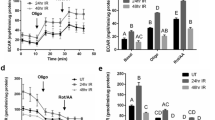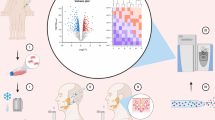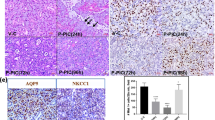Abstract
We evaluated late effects of AdhAQP1 administration in five subjects in a clinical trial for radiation-induced salivary hypofunction (http://www.clinicaltrials.gov/ct/show/NCT00372320?order=). All were identified as initially responding to human aquaporin-1 (hAQP1) gene transfer. They were followed for 3–4 years after AdhAQP1 delivery to one parotid gland. At intervals we examined salivary flow, xerostomic symptoms, saliva composition, vector presence and efficacy in the targeted gland, clinical laboratory data and adverse events. All displayed marked increases (71–500% above baseline) in parotid flow 3–4.7 years after treatment, with improved symptoms for ~2–3 years. There were some changes in [Na+] and [Cl−] consistent with elevated salivary flow, but no uniform changes in secretion of key parotid proteins. There were no clinically significant adverse events, nor consistent negative changes in laboratory parameters. One subject underwent a core needle biopsy of the targeted parotid gland 3.1 years post treatment and displayed evidence of hAQP1 protein in acinar, but not duct, cell membranes. All subjects responding to hAQP1 gene transfer initially had benefits for much longer times. First-generation adenoviral vectors typically yield transit effects, but these data show beneficial effects can continue years after parotid gland delivery.
This is a preview of subscription content, access via your institution
Access options
Subscribe to this journal
Receive 12 print issues and online access
$259.00 per year
only $21.58 per issue
Buy this article
- Purchase on Springer Link
- Instant access to full article PDF
Prices may be subject to local taxes which are calculated during checkout







Similar content being viewed by others
References
Jensen SB, Pedersen AM, Vissink A, Andersen E, Brown CG, Davies AN et al. A systematic review of salivary gland hypofunction and xerostomia induced by cancer therapies: prevalence, severity and impact on quality of life. Support Care Cancer 2010; 18: 1039–1060.
Vissink A, van Luijk P, Langendijk JA, Coppes RP . Current ideas to reduce or salvage radiation damage to salivary glands. Oral Dis 2015; 21: e1–e10.
Schwartz-Arad D, Arber L, Arber N, Zajicek G, Michaeli Y . The rat parotid gland – a renewing cell population. J Anat 1988; 161: 143–151.
Redman RS . Proliferative activity by cell type in the developing rat parotid gland. Anat Rec 1995; 241: 529–540.
Van Luijk P, Pringle S, Deasy JO, Moiseenko VV, Faber H, Hovan A et al. Sparing the region of the salivary gland containing stem cells preserves saliva production after radiotherapy for head and neck cancer. Sci Transl Med 2015; 7: 305ra147.
Cox JD, Stetz J, Pajak TF . Toxicity criteria of the Radiation Therapy Oncology Group (RTOG) and the European Organization for Research and Treatment of Cancer (EORTC). Int J Radiat Oncol Biol Phys 1995; 31: 1341–1346.
Mastrangeli A, O’Connell B, Aladib W, Fox PC, Baum BJ, Crystal RG . Direct in vivo adenovirus-mediated gene transfer to salivary glands. Am J Physiol 1994; 266: G1146–G1155.
Delporte C, O’Connell BC, He X, Lancaster HE, O’Connell AC, Agre P et al. Increased fluid secretion after adenoviral-medicated transfer of the aquaporin-1 cDNA to irradiated rat salivary glands. Proc Natl Acad Sci USA 1997; 94: 3268–3273.
Vitolo JM, Baum BJ . The use of gene transfer for the protection and repair of salivary glands. Oral Dis 2002; 8: 183–191.
Shan Z, Li J, Zheng C, Liu X, Fan Z, Zhang C et al. Increased fluid secretion after adenoviral-mediated transfer of the human aquaporin-1 cDNA to irradiated miniature pig parotid glands. Mol Ther 2005; 11: 444–445.
Preston GM, Agre P . Isolation of the cDNA for the erythrocyte integral membrane protein of 28 kilodaltons: member of an ancient channel family. Proc Natl Acad Sci USA 1991; 88: 11110–11114.
Baum BJ, Alevizos I, Zheng C, Cotrim AP, Liu S, McCullagh L et al. Early responses to adenoviral-mediated transfer of the aquaporin-1 cDNA for radiation-induced salivary hypofunction. Proc Natl Acad Sci USA 2012; 109: 19403–19407.
Wang Z, Zourelias L, Wu C, Edwards PC, Trombetta M, Passineau MJ . Ultrasound-assisted nonviral gene transfer of AQP1 to the irradiated minipig parotid gland restores fluid secretion. Gene Therapy 2015; 22: 739–749.
Diggle PJ, Heagerty P, Liang K-Y, Zeger SL. Analysis of longitudinal data.Oxford Statistical Science Series. Oxford University Press: Oxford, UK, 2002.
Pai S, Ghezzi EM, Ship JA . Development of a Visual Analogue Scale questionnaire of subjective assessment of salivary dysfunction. Oral Surg Oral Med Oral Pathol Oral Radiol Endod 2001; 91: 311–316.
Alevizos I, Zheng C, Cotrim AP, Goldsmith CM, McCullagh L, Berkowitz T et al Immune reactivity after adenoviral-mediated cDNA transfer to human parotid glands. Oral Dis2016, e-pub ahead of print 25 November 2016 doi:10.1111/odi.12614.
Gresz V, Kwon TH, Hurley PT, Varga G, Zelles T, Nielsen S et al. Identification and localization of aquaporin water channels in human salivary glands. Am J Physiol 2001; 281: G247–G254.
Harvey BG, Hackett NR, El-Sawy T, Rosengart TK, Hirschowitz EA, Lieberman MD et al. Variability of human systemic humoral immune responses to adenovirus gene transfer vectors administered to different organs. J Virol 1999; 73: 6729–6742.
Harvey BG, Hackett NR, Ely S, Crystal RG . Host responses and persistence of vector genome following intrabronchial administration of an E1 (-) E3 (-) adenovirus gene transfer vector to normal individuals. Mol Ther 2001; 3: 206–215.
Muona K, Makinen K, Hedman M, Manninen H, Yia-Herttuala S . 10-year safety follow-up in patients with local VEGF gene transfer to ischemic lower limb. Gene Therapy 2012; 19: 392–395.
Hendrikx R, Stichling N, Koelen J, Kuryk L, Lipiec A, Greber UF . Innate immunity to adenovirus. Hum Gene Ther 2014; 25: 265–284.
Seregen SS, Appledorn DM, McBride AJ, Schuldt NJ, Aldhamen YA, Voss T et al. Transient pretreatment with glucocorticoid ablates innate toxicity of systemically delivered adenoviral vectors without reducing efficacy. Mol Ther 2009; 17: 685–696.
Laakkonen JP, Yia-Herttuala S . Recent advances in cardiovascular gene therapy and vascular biology. Hum Gene Ther 2015; 26: 518–524.
Wang S, Baum BJ, Yamano S, Mankani MH, Sun D, Jonsson M et al. Adenoviral-mediated gene transfer to mouse salivary glands. J Dent Res 2000; 79: 701–708.
Kagami H, Atkinson JC, Michalek SM, Handelman B, Yu S, Baum BJ et al. Repetitive adenovirus administration to the parotid gland: role of immunological barriers and induction of oral tolerance. Hum Gene Ther 1998; 10: 305–313.
Li J, Zheng C, Zhang X, Liu X, Zhang C, Goldsmith CM et al. Development of a large animal model for gene transfer to salivary glands in vivo. J Gene Med 2004; 6: 55–63.
Voutetakis A, Zheng C, Metzger M, Cotrim AP, Donahue RE, Dunbar CE et al. Sorting of transgenic secretory proteins in rhesus macaque parotid glands after adenovirus-mediated gene transfer. Hum Gene Ther 2008; 19: 1401–1405.
Zheng C, Vitolo JM, Zhang W, Mineshiba F, Cjiorini JA, Baum BJ . Extended transgene expression from a nonintegrating adenoviral vector containing retroviral elements. Mol Ther 2008; 16: 1089–1097.
Zheng C, Baum BJ, Liu X, Goldsmith CM, Perez P, Jang SI et al. Persistence of hAQP1 expression in human salivary gland cells following AdhAQP1 transduction is associated with a lack of methylation of the hCMV promoter. Gene Therapy 2015; 22: 758–766.
Thaysen JH, Thorn NA, Schwartz IL . Excretion of sodium, potassium, chloride and carbon dioxide in human parotid saliva. Am J Physiol 1954; 178: 155–159.
Baum BJ . Principles of saliva secretion. Ann NY Acad Sci 1993; 694: 17–23.
Teos LY, Zheng C-Y, Liu X, Swaim WD, Goldsmith CM, Cotrim AP et al. Adenovirus-mediated hAQP1 expression in irradiated mouse salivary glands causes recovery of saliva secretion by enhancing acinar cell volume decrease. Gene Therapy 2016; 23: 572–579.
Atkinson JC, Yeh C-K, Bermudez D, Fox PC, Baum BJ . Longitudinal evaluation of major salivary gland function in HIV-1 infected patients. J Oral Pathol Med 1989; 18: 469–470.
Percival RS, Challacombe SJ, Marsh PD . Flow rates of resting whole and stimulated parotid saliva in relation to age and gender. J Dent Res 1994; 73: 1416–1420.
Ghezzi EM, Lange LA, Ship JA . Determination of variation of stimulated salivary flow rates. J Dent Res 2000; 79: 1874–1878.
Sprangers MC, Lakhai W, Koudstaal W, Verhoeven M, Koel BF, Vogels R et al. Quantifying adenovirus-neutralizing antibodies by luciferase transgene detection: addressing preexisting immunity to vaccine and gene therapy vectors. J Clin Microbiol 2003; 41: 5046–5052.
Zheng C, Nikolov NP, Alevizos I, Cotrim AP, Liu S, McCullagh L et al. Transient detection of E1-containing adenovirus in saliva after the delivery of a first-generation adenoviral vector to human parotid gland. J Gene Med 2010; 12: 3–10.
Nakamoto T, Brown DA, Catalán M, Gonzalez-Begne M, Romanenko VG, Melvin JE . Purinergic P2X7 receptors mediate ATP-induced saliva secretion by the mouse submandibular gland. J Biol Chem 2009; 284: 4815–4822.
Campese M, Sun X, Bosch JA, Oppenheim FG, Helmerhorst EJ . Concentration and fate of histatins and acidic proline-rich proteins in the oral environment. Arch Oral Biol 2009; 54: 345–353.
Acknowledgements
We are most grateful to the five responder-subjects (#19, 50, 99, 103 and 118), who gave so generously of their time and themselves for from 3 to 4.7 years. They enabled this long-term follow-up study to be conducted. In addition, we are sincerely appreciative of the Intramural Research Program of the National Institute of Dental and Craniofacial Research, which supported this study from its initial conception through its completion.
Author information
Authors and Affiliations
Corresponding author
Ethics declarations
Competing interests
BJ Baum currently serves as a consultant to GSK, but was not so engaged during this study. The remaining authors declare no conflict of interest.
Additional information
Supplementary Information accompanies this paper on Gene Therapy website
Supplementary information
Rights and permissions
About this article
Cite this article
Alevizos, I., Zheng, C., Cotrim, A. et al. Late responses to adenoviral-mediated transfer of the aquaporin-1 gene for radiation-induced salivary hypofunction. Gene Ther 24, 176–186 (2017). https://doi.org/10.1038/gt.2016.87
Received:
Revised:
Accepted:
Published:
Issue Date:
DOI: https://doi.org/10.1038/gt.2016.87
This article is cited by
-
Organ-specific extracellular matrix directs trans-differentiation of mesenchymal stem cells and formation of salivary gland-like organoids in vivo
Stem Cell Research & Therapy (2022)
-
Using cell sheets to regenerate mouse submandibular glands
npj Regenerative Medicine (2019)



